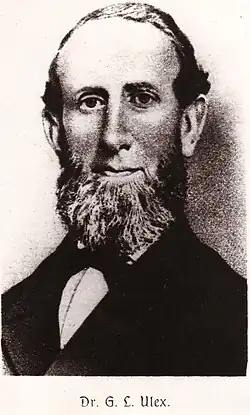Georg Ludwig Ulex
Georg Ludwig Ulex | |
|---|---|
 Georg Ludwig Ulex c. 1875 | |
| Born | 8 October 1811 |
| Died | 25 March 1883 |
| Occupation(s) | Chemist and politician |
Georg Ludwig Ulex (8 October 1811 – 25 March 1883) was a German chemist and politician.
Biography
Ulex was born in Neuhaus an der Oste, in Lower Saxony, Germany to Georg Friedrich Ulrich (1841–1907), a pharmacist in Hamburg. He apprenticed as a pharmacist himself in Hamburg, then studied in Berlin. Upon returning to Hamburg, he ran a pharmacy from 1839. From 1840 he taught chemistry and physics at the Hamburg pharmaceutical school, and in 1873 became a Handelschemiker (a commercial/forensic chemist), a post he held until his death.[1][2]
Ulex provided an early description of the phosphate mineral struvite in 1845, naming it in honour of geographer and geologist Heinrich Christian Gottfried von Struve (1772–1851) of Hamburg.[3]
The mineral ulexite was discovered in 1839 and named after him in 1840, in recognition of his publication of the first chemical analysis of the mineral.[4][5]
During the revolutions of 1848, Ulex was elected to the constituent assembly of Hamburg and assisted in drafting its new consitutution, adopted in 1860. He was a member of the Hamburg Constituent Assembly from 1859 to 1860, and a member of the Hamburg Parliament from 1862 to 1874.[2]
Ulex was awarded an honorary Ph.D. by the University of Rostock in 1871. He spent his final years in Altona, where he died in 1883.[1]
References
- ^ a b Pagel, Julius (1895). "Allgemeine Deutsche Biographie – Band 39: Ulex, Georg Ludwig (General German Biography – Vol. 39: Ulex, Georg Ludwig)". Duncker & Humblot. Retrieved 10 August 2025.
- ^ a b Alberti, Georg Christian Friedrich (1885). "Lexikon der Schleswig-Holstein-Lauenburgischen und Eutinischen Schriftsteller von 1866 bis 1882 (Lexicon of Schleswig-Holstein-Lauenburg and Eutin Authors from 1866 to 1882)". Verlag der Akademischen Buchhandlung. Retrieved 10 August 2025.
- ^ British Association of Urological Surgeons (2014). "Struvite Stones – BAUS Museum Poster" (PDF). BAUS. Retrieved 10 August 2025.
- ^ Ulex, G.L. (1849). "Ueber eine natürliche borsaure Verbindung" [On a natural compound of boric acid]. Annalen der Chemie und Pharmacie (in German). 70: 49–52. doi:10.1002/jlac.18490700107.
- ^ "Ulexite". Mindat.org. Retrieved 10 August 2025.